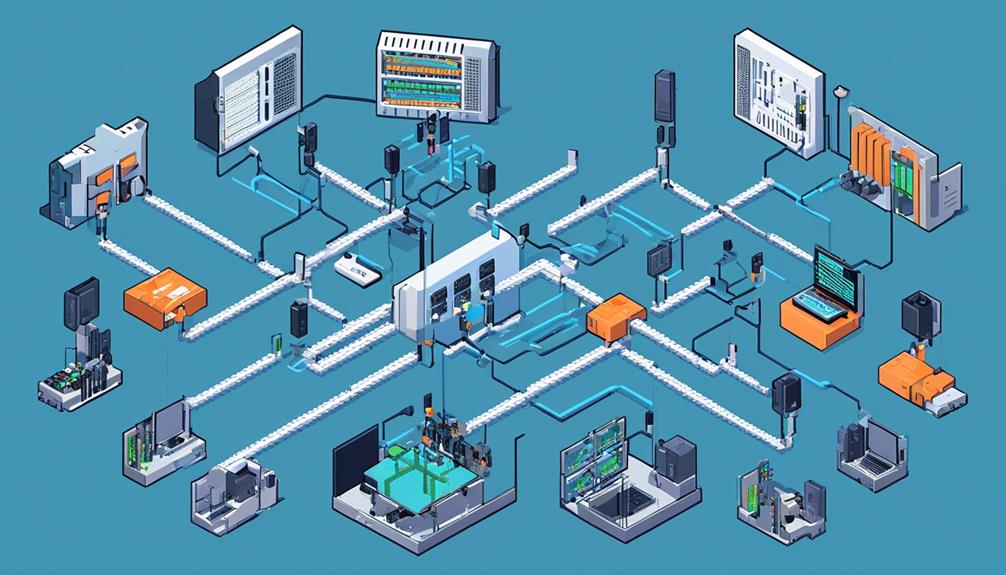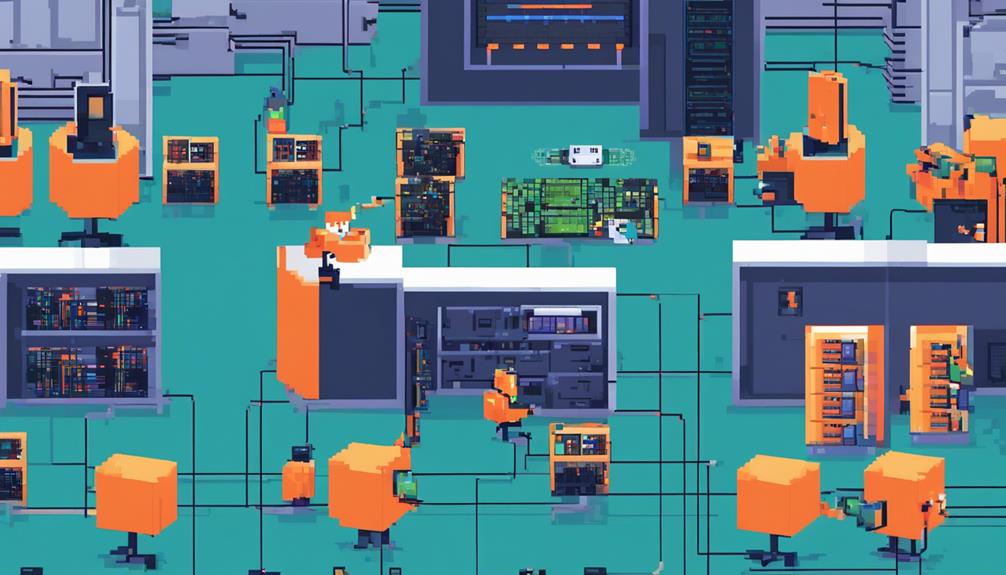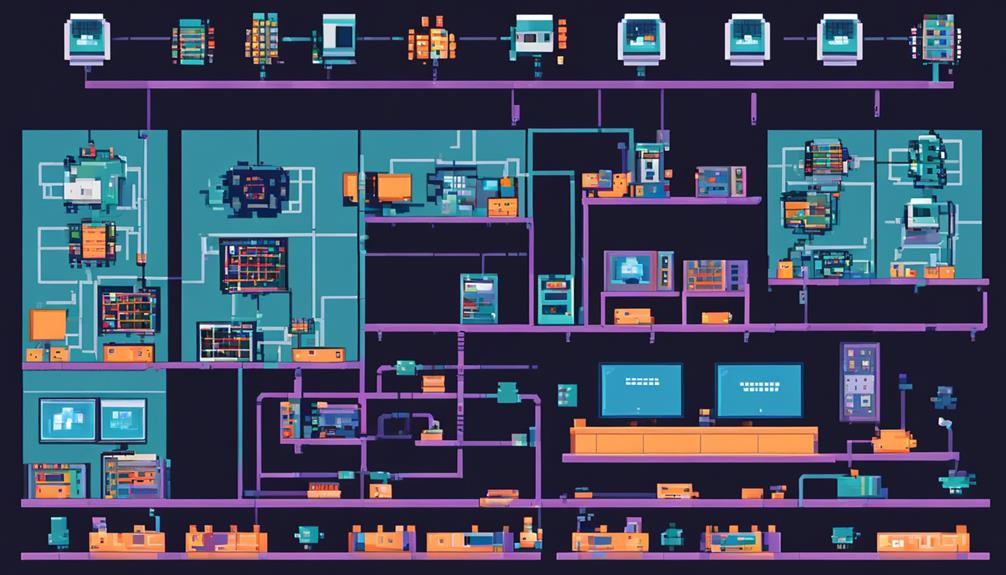The integration of Power over Ethernet (PoE) devices in networking has revolutionized the way we power and connect various devices. From wireless access points to IP cameras and IoT sensors, PoE technology has simplified installation, enhanced flexibility, and resulted in cost savings.
However, there are important considerations to keep in mind when implementing PoE, such as power requirements, cable quality, and network security. In this discussion, we will explore the different types of PoE devices, their benefits, and the factors to consider for successful implementation.
So, let's dive into the world of PoE devices and uncover the possibilities they bring to networking.
Key Takeaways
- PoE devices, such as PoE switches, injectors, and extenders, deliver power and data over Ethernet cables, eliminating the need for separate power supplies and outlets.
- PoE splitters and adapters enable non-PoE devices to receive power through PoE technology, saving time, cost, and effort.
- PoE cameras, access points, and VoIP phones streamline installation by integrating power and data transmission through a single Ethernet cable.
- PoE LED lighting, wireless bridges, door access controllers, network video recorders, and sensors offer simplified installation, reduced costs, and centralized power management in various networking applications.
PoE Switches

PoE switches are essential networking devices that efficiently deliver both power and data over Ethernet cables to connected devices. These switches eliminate the need for separate power supplies and outlets, making installation easier and more cost-effective. With PoE switches, power can be provided to various PoE devices, such as wireless access points, IP cameras, and VoIP phones, through a single Ethernet cable.
PoE switches come in different power output standards, including PoE, PoE+, and Ultra PoE. The standard PoE provides up to 15.4W of power per port, while PoE+ offers up to 30W per port. Ultra PoE, on the other hand, can deliver up to 60W or even higher power output per port. These power output options cater to the varying power requirements of different PoE devices, ensuring optimal performance and functionality.
There are two types of PoE switches: endspan and midspan. Endspan switches have the PoE functionality built into the switch itself, making them convenient for powering PoE devices directly. Midspan switches, on the other hand, are added between a non-PoE switch and a PoE device. These switches inject power into the Ethernet cable, enabling non-PoE switches to support PoE devices.
PoE Injectors
A PoE injector is a crucial device in networking that allows electrical current to be introduced into an Ethernet cable. It is used to power devices that are not Power over Ethernet (PoE)-compatible, enabling them to receive power and data signals over the same Ethernet cable. PoE injectors are commonly used to power devices such as wireless access points and IP cameras.
One key advantage of PoE injectors is their ability to extend the range of power transmission beyond the standard 100 meters of an Ethernet cable. This is particularly useful in scenarios where devices are located far away from a power source or where additional power sourcing equipment is not available. By using PoE injectors, organizations can simplify their network infrastructure and reduce the need for additional power outlets.
To further emphasize the benefits of PoE injectors, consider the following nested bullet point list:
- PoE injectors provide a cost-effective solution for powering PoE-compatible devices, eliminating the need for separate power cables and outlets.
- This simplifies installation and reduces maintenance efforts.
- It also improves flexibility in device placement, as devices can be powered and connected anywhere within the reach of an Ethernet cable.
- PoE injectors support various PoE standards, including IEEE 802.3af and IEEE 802.3at, allowing compatibility with a wide range of PoE devices.
- This ensures interoperability and facilitates the integration of PoE injectors into existing network infrastructures.
PoE Extenders

To continue expanding on the topic of power over Ethernet, the next aspect to be explored is the use of PoE extenders.
PoE extenders are devices that increase the transmission distance of PoE beyond the standard 100 meters. They are designed to power and connect PoE devices such as IP cameras, wireless access points, and other network devices over longer distances.
One of the main advantages of PoE extenders is that they allow for more flexible placement of devices. By overcoming the distance limitation of 100 meters, PoE extenders enable users to install PoE devices in locations that are further away from the power source or network switch. This can be particularly useful in large buildings or outdoor environments where running additional power cables may not be feasible or cost-effective.
PoE extenders operate by regenerating the PoE signal and power, allowing it to be transmitted over longer Ethernet cables. These devices essentially amplify and regenerate the power and data signals, ensuring that they reach the intended devices without any loss or degradation. This enables the PoE devices to receive the necessary power and data for their operation, even when they are located far away from the network switch or power source.
In addition to extending the reach of PoE networks, PoE extenders provide a cost-effective solution. They eliminate the need for additional power sources, as the power is carried along with the data over the Ethernet cables. This simplifies the installation process and reduces the overall infrastructure costs.
PoE Splitters
Power over Ethernet (PoE) splitters are essential devices for extracting power from an Ethernet cable and delivering it to non-PoE devices. These devices play a crucial role in enabling power distribution over Ethernet infrastructure.
Here are some key points about PoE splitters:
- Power extraction: PoE splitters split the power from the data signal, allowing non-PoE devices to be powered over Ethernet. They extract power from the Ethernet cable and convert it into a usable form for non-PoE devices.
- Compatibility: PoE splitters are often used to power devices like IP cameras, access points, and VoIP phones that are not PoE-compatible. These devices may require electrical power to function, and PoE splitters provide a convenient solution by utilizing the existing Ethernet infrastructure.
- Infrastructure utilization: PoE splitters can be useful in situations where PoE switches are already in place. Instead of investing in additional power outlets or wiring, non-PoE devices can benefit from the existing PoE infrastructure. This saves time, cost, and effort in deploying power to multiple devices.
- Flexibility: PoE splitters offer flexibility in device placement as they eliminate the need for separate power supplies. Non-PoE devices can be installed in locations where power outlets are scarce or inconveniently located, making them ideal for scenarios where flexibility is a priority.
- Simplified installation: The use of PoE splitters simplifies installation and reduces cable clutter. By combining power and data transmission over a single Ethernet cable, the need for additional power cords is eliminated, resulting in a cleaner and more organized network setup.
Power over Ethernet (PoE) splitters are an essential component in optimizing the use of Ethernet infrastructure by enabling the integration of power and data. They provide a cost-effective and efficient solution for powering non-PoE devices, enhancing flexibility, and simplifying installation in various networking applications.
PoE Adapters

PoE adapters, also known as power over Ethernet adapters, enable non-PoE devices to receive power through PoE technology. These adapters are a convenient solution for retrofitting existing devices with PoE capabilities, allowing them to be powered using a single Ethernet cable. PoE adapters typically come in two forms: injectors and splitters.
Injectors add power to the Ethernet cable, making it possible to power non-PoE devices directly from a PoE switch or injector. This eliminates the need for separate power cables and outlets, simplifying installation and reducing clutter. Injectors are commonly used in scenarios where a single non-PoE device needs to be powered over Ethernet.
On the other hand, splitters separate data and power for use by non-PoE devices. They allow the Ethernet cable to be used for both data transmission and power delivery, without requiring PoE capabilities on the network switch or injector. Splitters are useful in situations where multiple non-PoE devices need to be powered from a single PoE source.
By using PoE adapters, organizations can expand the flexibility and benefits of PoE technology to a wider range of devices. This includes devices such as IP cameras, wireless access points, VoIP phones, and other network devices that do not have built-in PoE support. PoE adapters provide a cost-effective and efficient way to power these devices, simplifying installation and enhancing network flexibility.
To better understand the differences between injectors and splitters, refer to the table below:
| Injectors | Splitters | |
|---|---|---|
| Function | Add power to Ethernet cable | Separate data and power |
| Usage | Powers a single non-PoE device | Powers multiple non-PoE devices |
| Connection | Connects to PoE switch or injector | Connects to PoE source and devices |
| Benefits | Simplifies installation, reduces clutter | Allows multiple devices to be powered |
PoE Cameras
PoE cameras offer a streamlined solution for both power and data transmission in video surveillance applications. By utilizing PoE technology, these cameras are capable of receiving power and transmitting data through a single Ethernet cable. This eliminates the need for separate power sources and simplifies installation, making PoE cameras an efficient and cost-effective choice for security systems.
Here are two key advantages of PoE cameras:
- Simplified deployment: PoE cameras can be powered by PoE switches, injectors, or midspan devices, providing flexibility in deployment. This eliminates the reliance on traditional power outlets, allowing for easy installation in various settings such as businesses, homes, and public spaces. With PoE, security cameras can be placed in optimal locations without the constraints of power availability.
- Seamless integration: PoE cameras can be seamlessly integrated into existing PoE network infrastructures. This offers scalability and centralized power management, making it easier to expand and manage surveillance systems. With the advancement of PoE standards, modern PoE cameras can support higher power outputs, enabling the integration of advanced features like PTZ functionality and higher resolution imaging.
Furthermore, PoE cameras provide a reliable and secure solution for transmitting power and data over Ethernet cabling. This eliminates the need for additional wiring, reducing installation costs and maintenance efforts. With PoE technology, security cameras can be efficiently powered and data can be transmitted without interference, ensuring the continuous operation of video surveillance systems.
PoE Access Points

PoE access points, also known as PoE APs, are essential components in network infrastructure. They enable wireless connectivity while being powered through Ethernet cables.
The benefits of using PoE APs are significant. They eliminate the need for separate power sources, which simplifies installation and reduces costs.
When installing PoE APs, it is important to ensure compatibility with PoE switches or injectors for power supply. Strategic placement is also crucial for optimal network coverage.
Powering Network Access Points
Powering network access points can be achieved through the use of Power over Ethernet (PoE) technology. PoE enables the transmission of electrical power through Ethernet cables, eliminating the need for separate power cords and wiring. This technology is widely used in both smart home applications and business premises, providing cost savings and simplified installation by utilizing cheaper Ethernet cabling.
The development of PoE in 2003 was instrumental in supporting devices like wireless access points, reducing the requirement for separate power and data wiring. PoE-compatible devices can function seamlessly without modification, while non-PoE devices may require the installation of a picker or tap to extract the current from the cable.
Commonly powered by PoE are devices such as IP phones, video telephones, wireless AP devices, pan-tilt-zoom cameras, remote computer terminals, and network audio systems.
Benefits of PoE APs
The utilization of PoE access points (PoE APs) offers numerous benefits in networking installations. By delivering electrical power through the Ethernet cable, PoE APs simplify installation, eliminating the need for separate electrical outlets and reducing time and cost.
This also allows for flexible placement and repositioning of devices, without being constrained by power cord length. Furthermore, PoE APs incorporate safety features, such as intelligent power delivery and the ability to stop power currents during service interruptions. This ensures reliable power supply, enhancing network performance and stability.
Additionally, PoE APs enable scalable distribution of power and network connections, supporting the growth and expansion of network infrastructure. Overall, the use of PoE APs brings convenience, efficiency, and reliability to networking installations.
Poe AP Installation Tips
With the benefits of PoE APs in mind, it is important to consider key installation tips when deploying PoE access points in networking environments. Here are some important considerations:
- Use a PoE switch: Consider using a PoE switch to power multiple devices through a single connection, simplifying the power delivery process.
- Verify compatibility: Ensure that the PoE injector or switch and access point are compatible to avoid any compatibility issues during installation.
- Power requirements: Verify the power requirements of the access point to ensure that the PoE switch provides sufficient power for proper functioning.
- Distance limitations: Keep in mind the distance limitations of PoE (100m) and use extenders if needed to reach the desired installation location for the access point.
- Network security: When installing PoE access points, ensure proper network security measures are in place to protect the devices from unauthorized access or potential security threats.
PoE VoIP Phones

PoE VoIP phones revolutionize communication installations by seamlessly integrating power and data through Ethernet cables. These devices leverage the power of PoE technology, eliminating the need for separate power cords and simplifying installation. By combining data connection and power into a single cable, PoE VoIP phones offer increased flexibility and convenience.
One of the key advantages of PoE VoIP phones is their ability to receive power through Ethernet cables. This eliminates the need for additional power cords, making installation more streamlined and efficient. With the power and data transmitted over the same cable, there is no need for separate power outlets near the phone, allowing for greater freedom in positioning the devices.
PoE VoIP phones can be powered by different PoE wattages, such as 13W or 30W, depending on the specific model and power requirements. This flexibility allows for compatibility with various power sources and ensures that the phones can be powered adequately for their intended use.
The integration of power and data through Ethernet cables enables PoE VoIP phones to seamlessly connect to the network infrastructure. This integration enhances the overall communication system by simplifying cable management and reducing clutter. Additionally, PoE VoIP phones can be easily relocated without the need for additional power sources, providing flexibility in office layouts and reconfigurations.
PoE LED Lighting
PoE LED Lighting integrates power and control of LED fixtures, revolutionizing installation and reducing costs. This technology allows for the powering and control of LED fixtures over Ethernet cables, eliminating the need for separate power supplies. Here are some key points to highlight the benefits and features of PoE LED lighting:
- Simplified Installation:
- PoE LED lighting enables the integration of lighting with network infrastructure, providing flexibility in placement and control.
- With power available through the Ethernet cable, there is no need for additional electrical wiring, making installation faster and more cost-effective.
- It eliminates the need for separate power outlets near each fixture, allowing for more freedom in fixture placement and minimizing disruptions to existing structures.
- Efficient Power Delivery and Control:
- PoE LED lighting ensures efficient power delivery and control, contributing to energy savings and smart building management.
- It allows for centralized control and monitoring of lighting systems, enabling adjustments and scheduling based on occupancy or daylight levels.
- With the ability to transmit Ethernet data alongside power, PoE LED lighting provides a seamless integration with other network devices, enabling advanced lighting control systems and automation.
PoE LED lighting is part of the new IEEE 802.3bt standard, supporting high-power devices like LED fixtures. This standard expands the application of PoE technology in various environments, from commercial buildings to outdoor spaces. By leveraging the power and convenience of Ethernet, PoE LED lighting offers a cost-effective and flexible solution for modern lighting systems.
PoE Wireless Bridges

PoE wireless bridges enable long-distance extension of wireless connectivity, leveraging PoE technology to deliver both power and data to network devices. These devices use the PoE standard, which allows power to be transmitted over the same network cable that carries data. By eliminating the need for separate power sources, PoE wireless bridges simplify installation and reduce costs.
One of the key advantages of PoE wireless bridges is their ability to eliminate power loss over long distances. Traditional wireless bridges often suffer from power loss due to the distance between the power source and the network device. With PoE technology, power is delivered directly to the device, ensuring consistent and reliable power supply.
PoE wireless bridges are particularly useful in outdoor or challenging environments where running power cables may be difficult or costly. They can be used to create point-to-point or point-to-multipoint wireless connections, connecting remote buildings or extending wireless coverage to areas with limited power access.
The use of PoE wireless bridges also provides flexibility in network design and deployment. They can be easily integrated into existing Ethernet (PoE) networks, allowing for seamless connectivity. Furthermore, they eliminate the need for additional power outlets, reducing installation complexity and clutter.
PoE Door Access Controllers
Door access controllers that utilize Power over Ethernet (PoE) technology provide a streamlined and cost-effective solution for integrating power and data transmission in security and access control systems. These controllers eliminate the need for separate power connections by delivering power and data over standard Ethernet cables. This not only simplifies the installation process but also reduces the costs associated with running additional electrical cables and power supplies.
The use of PoE Door Access Controllers offers several advantages over traditional access control systems:
- Easy installation: With PoE technology, door access controllers can be easily installed without the need for electrical outlets. This allows for flexible placement and positioning of access control devices, without the limitations of traditional power sources.
- Centralized power distribution: PoE Door Access Controllers are compatible with PoE switches and injectors, enabling centralized power distribution and management. This centralized approach simplifies maintenance and troubleshooting, as power can be controlled and monitored from a single point.
PoE IP Intercoms

Are you looking for a streamlined and cost-effective solution for integrating power and data transmission in your security and access control systems? PoE IP Intercoms offer the perfect solution by utilizing Power over Ethernet (PoE) technology. These intercoms allow for the transmission of both power and data through a single Ethernet cable, eliminating the need for separate power supplies and outlets. This not only simplifies installation but also reduces costs.
PoE IP Intercoms are compatible with PoE switches and injectors, making them easy to integrate into existing network infrastructures. They can be powered through the Ethernet cable, providing flexibility in device placement and repositioning. This is particularly useful in scenarios where power outlets may not be easily accessible.
These intercoms are ideal for a variety of applications, including building access control, security systems, and communication in smart home and business environments. They support real-time communication and audiovisual capabilities over Ethernet networks, ensuring seamless and efficient operation.
To further understand the benefits of PoE IP Intercoms, let's take a look at the following table:
| Feature | Description |
|---|---|
| Power Integration | Simultaneous power and data transmission over Ethernet cable |
| Cost Savings | Eliminates the need for separate power supplies and outlets |
| Flexibility | Allows for easy device placement and repositioning |
| Compatibility | Works seamlessly with PoE switches and injectors |
| Applications | Suitable for access control, security systems, and more |
It is worth noting that PoE IP Intercoms comply with the IEEE 802.3bt standard, ensuring compatibility and interoperability with other PoE devices. With their efficient power and data integration, these intercoms provide a reliable and convenient solution for security and access control systems.
PoE Network Video Recorders
To continue our exploration of power and data integration in network systems, let's now delve into the realm of PoE Network Video Recorders (NVRs). These devices enable the seamless integration of power and data transmission for IP cameras, simplifying installation and reducing costs.
One of the key features of PoE NVRs is their ability to power and receive data from IP cameras over a single Ethernet cable. This eliminates the need for separate power sources or injectors, streamlining the installation process. By directly connecting and powering IP cameras, PoE NVRs provide centralized power management for the entire surveillance system.
Here are two important points to emphasize about PoE NVRs:
- Simplified Installation: With built-in PoE ports, PoE NVRs enable easy and efficient camera placement. Traditional power outlets are no longer required, offering greater flexibility in surveillance system design. This is particularly beneficial in locations where power sources are limited or difficult to access.
- Scalability and Efficiency: PoE NVRs support high-speed data transmission, ensuring smooth and reliable operation of IP camera systems. This scalability allows for the expansion of surveillance systems without the constraints of traditional power outlets, making them ideal for various applications.
PoE Sensors

PoE Sensors, which can be integrated into various applications, offer a streamlined and cost-effective solution for powering and connecting devices through Ethernet cables. These sensors eliminate the need for separate power supplies and simplify installation by leveraging existing Ethernet infrastructure. With PoE technology, sensors can transmit data and receive power simultaneously, reducing complexity and costs associated with additional electrical wiring.
By using Ethernet cables for both data transmission and power supply, PoE Sensors provide flexibility in deployment. They can be easily installed in locations where traditional power sources are not readily available, such as remote areas or outdoor environments. This makes them ideal for building automation systems, security devices, and environmental monitoring equipment.
PoE Sensors adhere to IEEE 802.3 standards, ensuring compatibility within PoE networks. They can be powered by PoE switches or injectors, which deliver power over the Ethernet cable. This eliminates the need for separate power cables and reduces the overall cost of installation. Furthermore, PoE Sensors can be centrally managed and controlled, providing a more efficient and convenient solution for monitoring and managing connected devices.
In addition to their cost-effectiveness and ease of installation, PoE Sensors offer scalability. As the number of devices in a network grows, additional PoE switches or injectors can be easily added to provide power to the expanding network. This scalability allows for future expansion without the need for extensive rewiring or infrastructure changes.
Frequently Asked Questions
What Is a Poe Networking Device?
A PoE networking device is a type of network equipment that is capable of carrying electrical power through Ethernet data cables, eliminating the need for separate power cords and wiring.
This technology simplifies installation and reduces costs, making it popular in smart home applications and business premises.
PoE devices support various devices such as IP phones, wireless AP devices, remote computer terminals, and door access systems.
They offer benefits such as ease of installation and cost savings, making them a convenient choice for networking solutions.
What Is an Example of a Poe Device?
An example of a PoE device is an IP camera. These devices can receive power through an Ethernet cable, eliminating the need for a separate power source. This not only simplifies installation by reducing the number of cables required, but also offers the benefits of cost savings and increased flexibility.
PoE technology allows for compatibility between various devices, such as wireless access points, VoIP phones, door access systems, and digital signage displays, all of which can be powered using the same Ethernet cable.
What Devices Are Powered by Poe?
PoE devices are widely used in various industries for their many benefits. They simplify network installation and maintenance by eliminating the need for separate power sources, reducing clutter and cost.
Common applications include IP phones, video telephones, wireless AP devices, and robotic cameras. PoE technology also powers remote computer terminals, monitors, and display screens.
Advancements in PoE, such as the new IEEE 802.3bt standard, support devices like LED lighting, security card readers, and video surveillance cameras, indicating a promising future for PoE device technology.
Is a Router a Poe Device?
A router is not inherently a PoE device, but some routers have the capability to receive power over Ethernet connections. This feature can provide numerous benefits, such as simplified installation and the ability to power other PoE devices connected to the router.
However, not all routers support PoE, so it's important to check the specifications. PoE technology is becoming increasingly popular in networking, offering a more streamlined and flexible solution for power distribution in various environments.
